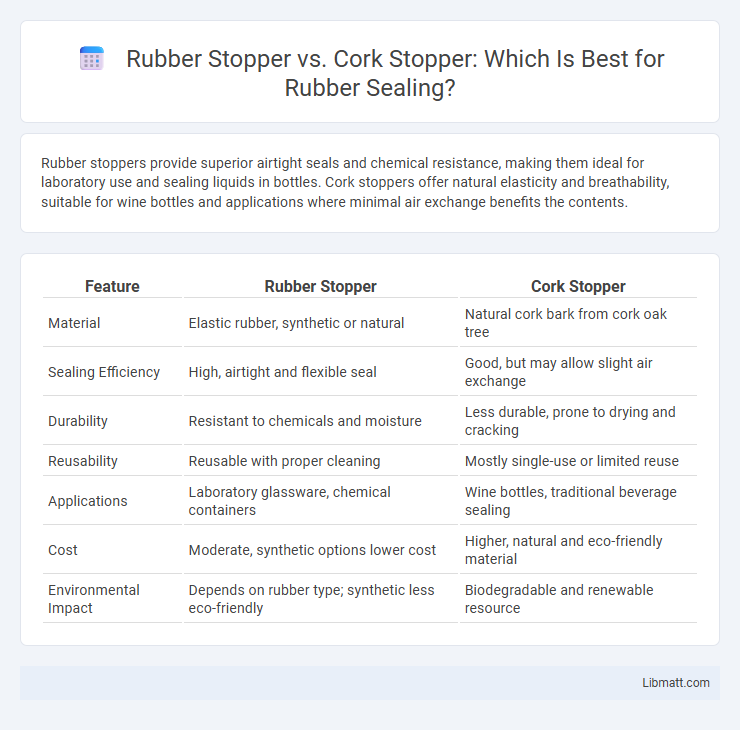Rubber stoppers provide superior airtight seals and chemical resistance, making them ideal for laboratory use and sealing liquids in bottles. Cork stoppers offer natural elasticity and breathability, suitable for wine bottles and applications where minimal air exchange benefits the contents.
Table of Comparison
| Feature | Rubber Stopper | Cork Stopper |
|---|---|---|
| Material | Elastic rubber, synthetic or natural | Natural cork bark from cork oak tree |
| Sealing Efficiency | High, airtight and flexible seal | Good, but may allow slight air exchange |
| Durability | Resistant to chemicals and moisture | Less durable, prone to drying and cracking |
| Reusability | Reusable with proper cleaning | Mostly single-use or limited reuse |
| Applications | Laboratory glassware, chemical containers | Wine bottles, traditional beverage sealing |
| Cost | Moderate, synthetic options lower cost | Higher, natural and eco-friendly material |
| Environmental Impact | Depends on rubber type; synthetic less eco-friendly | Biodegradable and renewable resource |
Introduction to Bottle Stoppers
Rubber stoppers and cork stoppers are essential bottle sealing solutions used across industries including pharmaceuticals, winemaking, and laboratory settings. Rubber stoppers provide a tight seal, chemical resistance, and durability, making them ideal for airtight and contamination-free storage. Cork stoppers, derived from natural cork oak bark, offer breathability and a traditional aesthetic, commonly favored in wine bottling to allow controlled aging and preservation.
What Are Rubber Stoppers?
Rubber stoppers are flexible sealing devices made from natural or synthetic rubber compounds designed to create airtight closures for laboratory glassware such as test tubes, flasks, and bottles. They offer superior chemical resistance, durability, and elasticity, making them ideal for preventing leaks and contamination in chemical and biological experiments. Unlike cork stoppers, rubber stoppers provide a tighter seal and are less prone to drying out or crumbling over time.
What Are Cork Stoppers?
Cork stoppers are natural closures made from the bark of cork oak trees, prized for their ability to provide a tight seal while allowing minimal oxygen exchange, which helps preserve wine quality during aging. They offer elasticity and compressibility, ensuring a snug fit in bottle necks, and are biodegradable and sustainable, making them an eco-friendly option. If you're choosing between rubber stopper vs cork stopper, understanding cork's natural properties can help you select the best seal for your bottles.
Key Differences Between Rubber and Cork Stoppers
Rubber stoppers provide superior chemical resistance and airtight sealing ideal for laboratory and industrial use, while cork stoppers offer natural breathability and flexibility preferred in wine bottling. Rubber stoppers are durable, reusable, and resistant to degradation from liquids, unlike cork which can crumble or allow slow oxygen exchange. The choice depends on the application's need for impermeability, reusability, and material compatibility with stored substances.
Advantages of Rubber Stoppers
Rubber stoppers provide superior chemical resistance and create an airtight seal, which helps prevent contamination and maintain sample integrity in laboratory and industrial applications. Their flexibility and durability make them suitable for repeated use and adaptation to various container sizes, unlike cork stoppers that can degrade or crumble over time. Rubber stoppers also resist moisture and temperature variations, ensuring consistent performance in diverse environments.
Advantages of Cork Stoppers
Cork stoppers offer excellent elasticity and compressibility, creating an airtight seal while allowing minimal oxygen exchange, which benefits wine aging. Their natural, biodegradable composition makes them environmentally friendly compared to synthetic alternatives. Choosing cork stoppers ensures a traditional closure method that enhances the authenticity and value of your bottled products.
Limitations of Rubber Stoppers
Rubber stoppers have limitations such as reduced chemical resistance to strong solvents and susceptibility to degradation from heat and UV exposure, which can compromise the seal integrity. Unlike cork stoppers, rubber may absorb liquids over time, leading to potential contamination or loss of elasticity. When selecting a stopper for your application, consider these factors to ensure compatibility and durability.
Limitations of Cork Stoppers
Cork stoppers have limitations such as susceptibility to drying out and shrinking, which can lead to oxidation and spoilage of the sealed liquid. They are also prone to contamination by cork taint, caused by the compound TCA, which affects the aroma and taste of wine. Furthermore, corks have lower elasticity compared to rubber stoppers, making them less effective for resealing bottles multiple times.
Choosing the Right Stopper for Your Needs
Rubber stoppers provide superior chemical resistance and airtight sealing, making them ideal for laboratory applications requiring durability and tight containment. Cork stoppers offer natural breathability and flexibility, suitable for wine bottles and products needing slight gas exchange. Select rubber for chemical stability and moisture prevention, while cork is preferable for traditional packaging and environments where minimal permeability is beneficial.
Final Comparison: Rubber vs. Cork Stopper
Rubber stoppers offer superior chemical resistance, durability, and airtight sealing compared to cork stoppers, making them ideal for laboratory and industrial applications. Cork stoppers excel in natural elasticity and eco-friendliness, often preferred for wine bottles due to their ability to allow minimal oxygen exchange for aging. Overall, rubber stoppers provide consistent performance and longevity, while cork stoppers deliver traditional aesthetics and environmental benefits.
Rubber Stopper vs Cork Stopper Infographic

 libmatt.com
libmatt.com